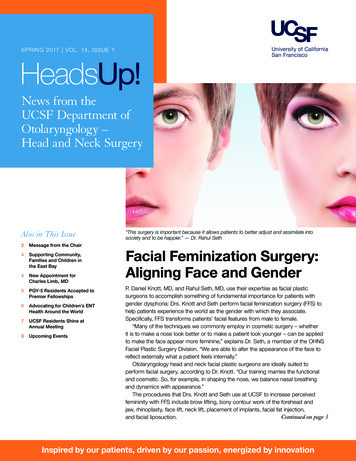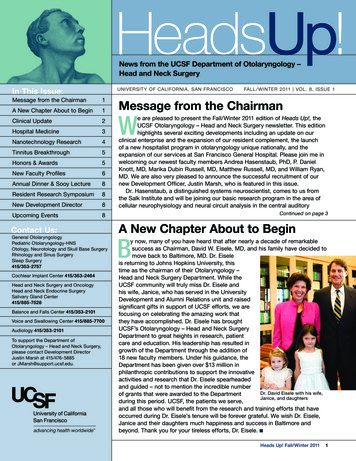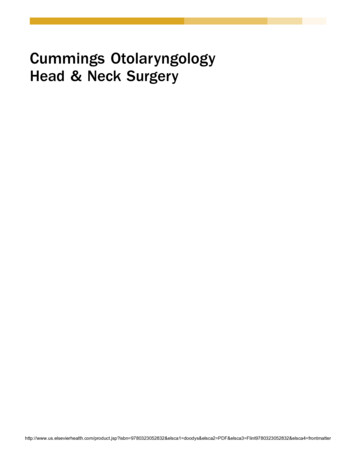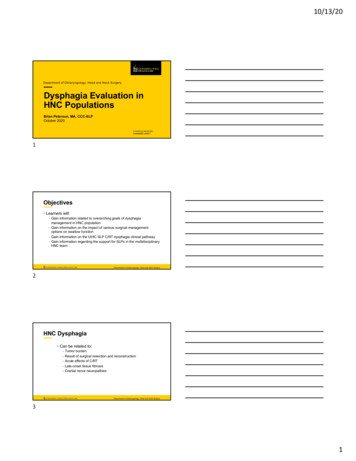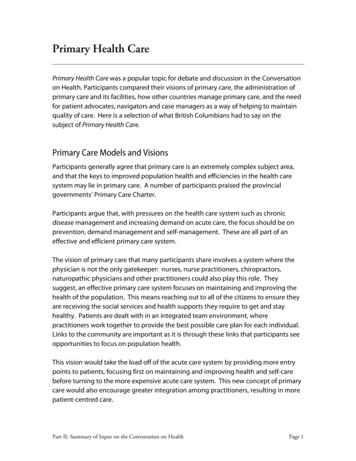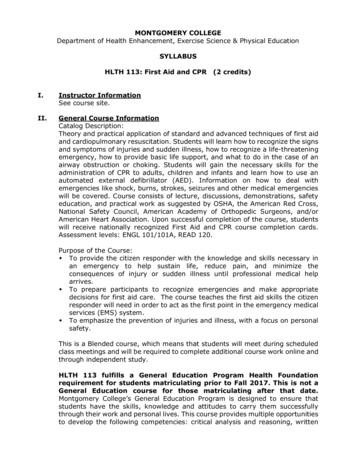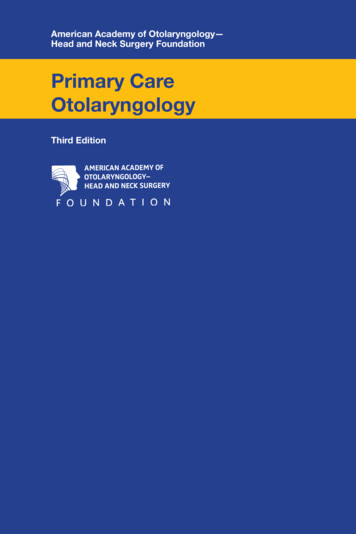
Transcription
American Academy of Otolaryngology—Head and Neck Surgery FoundationPrimary CareOtolaryngologyThird Edition
2011 All materials in this eBook are copyrighted by the AmericanAcademy of Otolaryngology—Head and Neck Surgery Foundation, 1650Diagonal Road, Alexandria, VA 22314-2857, and are strictly prohibited tobe used for any purpose without prior express written authorizations fromthe American Academy of Otolaryngology—Head and Neck SurgeryFoundation. All rights reserved.For more information, visit our website at www.entnet.org.Print: First Edition 2001, Second Edition 2004eBook Format: Second Edition 2004, Third Edition 2011ISBN: 978-0-615-46523-4
PrefaceDr. Gregory Staffel first authored this short introduction to otolaryngologyfor medical students at the University of Texas School for the HealthSciences in San Antonio in 1996. Written in conversational style, pepperedwith hints for learning (such as “read an hour a day”), and short enough todigest in one or two evenings, the book was a hit with medical students.Dr. Staffel graciously donated his book to the American Academy ofOtolaryngology—Head and Neck Surgery Foundation to be used as abasis for this primer. It has been revised and edited, and is now in its thirdprinting. This edition has undergone an extensive review, revision, andupdating. We are grateful to the many authors and reviewers who havecontributed over the years to the success of this publication. We believethat you, the reader, will find this book enjoyable and informative. Weanticipate that it will whet your appetite for further learning in the discipline that we love and have found most intriguing. It should start yourjourney into otolaryngology, the field of head and neck surgery.Enjoy!Mark K. Wax, MD, EditorCoordinator, Education Steering CommitteeAmerican Academy of Otolaryngology—Head and Neck SurgeryFoundationCHAPTER 1www.entnet.org1
Contents1. Introduction to Clinical Rotation.42. Evaluating and Keeping Track of Patients.93. Presenting on Rounds.174. ENT Emergencies.215. Otitis Media.316. Hearing Loss.417. Dizziness.498. Facial Nerve Paralysis.559. Rhinology, Nasal Obstruction, and Sinusitis.6010. Allergy.6911. How to Read a Sinus CT Scan.7412. Maxillofacial Trauma.7913. Facial Plastic Surgery.8614. Salivary Gland Disease.9315. Thyroid Cancer.9816. Head and Neck Cancer.10517. Skin Cancer.11518. Pediatric Otolaryngology.120www.entnet.org3
CHAPTER 1Introduction toClinical Rotation4The goals of this book are to make good clinicians out of medical studentsand to teach the basics of Otolaryngology—Head and Neck Surgery.Sometimes individuals have trouble transitioning from being second-yearmedical students, where they are truly students, to becoming healthcareprofessionals. This metamorphosis over the third and fourth years of medical school involves learning how to carry yourself and act as a healthcareprofessional.To meet this first goal and become a good clinician, it is helpful for students to be carefully observant of their professors in important but unnoticed aspects, such as their demeanor, comments, and interaction withhouse staff and patients. Students learn a lot through observing care ofpatients. The process starts with the student’s appearance (clothing andgrooming), punctuality, composure, acceptance of responsibility, andinteractions with patients and other healthcare team members. You needto really listen to patients.It can be difficult to understand a medical student’s role in the healthcareteam. Work to become an active member of the team. Interns, residents,and attendings are overworked and spread quite thin. However, medicalstudents frequently have extra time to spend with their patients, talking tothe patients about their past medical problems, family, and social historyas they pertain to their disease process. Most important, work towardestablishing a true patient-physician relationship. This type of relationshipestablishes the medical student as an important part of the healthcareteam, beneficial to the overall care provided to the patient. For the medicalstudent, it also establishes long-term behaviors that translate into thedevelopment of an excellent future physician.A few basic rules will help you to become a good clinician. During thethird year, there may be conflicting responsibilities, such as being at a lecture while needing to draw a patient’s blood. In general, the priorityPrimary Care Otolaryngology
INTRODUCTION TO CLINICAL ROTATIONshould be the care of the patient. If it is an important blood test and youcannot get someone to do it for you, you may need to miss the lecture.These situations don’t actually come up that often, and if patient care is themain goal, over the long run, most people will respect these decisions.There are two kinds of physicians: those who read and those who don’t.Read about your patients’ conditions. You should read textbooks becausethey cover the basics, and 90 percent of people do not know what is inthem. Articles are for later. It does not matter which textbook you read,because if the information is important, it will come up again in laterreading. If the information is unimportant, it will not come up very often.So now you have four patients and you go home. You got up at 5:00 a.m.to make it to rounds. You get home at 7:00 p.m. after your last post-opnote. After you have petted the dog and had something to eat, it is 8:30.You deserve a break, so you watch TV for an hour. You are ready to read,and recall from your notes that your patient has hypertension, chronicobstructive pulmonary disease, diabetes, and a pleomorphic adenoma.There is no way you can read about all that tonight, and you have to get upat 5:00 a.m. tomorrow. So you go to bed, and the next morning you do notreally know why we even treat asymptomatic hypertension in the firstplace. Solution: Read for an hour every day. Afterward you can do whatever you want and not feel guilty or overwhelmed. You will also be amazedat how well you do. Most students do not average anywhere near an hourof daily reading. Read about your patients. Remember Darwin’s theory ofmedical education: “It cannot be that rare if you are seeing it.”We know that you, as medical students, aspire to the highest ideals of professionalism. We know that you will always have a neat appearance and apleasant personality. We know that you will do completely thorough histories and physicals. You will be very compassionate to all your patients andcoworkers, and you will always be willing and ready to learn. It has beenour experience that all students know this is expected of them. However,there is one important caveat that is often not addressed in medical education: It is as much your responsibility to know your limitations as it is toknow about treating patients. If you are trying hard, reading an hour everyday, and truly interested, then if you are asked a question to which you donot know the answer, it is perfectly legitimate, and indeed expected, thatyou simply answer, “I don’t know.” Nobody knows everything.If you use the information you already have, you will often do surprisinglywell if you guess at an answer. But if your answer is only a guess, qualify itby pointing out that you do not specifically know the answer. Integrity—www.entnet.org5
CHAPTER 1an absolute commitment to honesty—is a prerequisite for becoming aphysician.Although you may not know that much yet in your clinical career, youhave one secret weapon as a student: enthusiasm. Residents are often tiredand grouchy, as you probably have noticed, but having an enthusiastic student around makes a difference.6The second goal of this book is to teach you a little about common ear,nose, and throat (ENT) problems. Since the great majority of you will notbecome otolaryngologists, it becomes much more important for you tounderstand how to recognize potentially dangerous problems that shouldbe referred to an otolaryngologist, as well as how to manage uncomplicated problems that can be taken care of at the primary care level.Primary Care Otolaryngology
INTRODUCTION TO CLINICAL ROTATIONQUESTIONS1.Your highest professional priority throughout your third year and therest of your career should be .2.One way to learn as much as possible, without feeling overwhelmed,during the third year is to .3.When faced with two conflicting responsibilities, shouldalways be your highest priority.4.If you guess at a question on rounds, you should .5.The key to a happy career in medicine is to make yourhighest professional priority.6.In all countries of the world, a common vein through medicine is tokeep as the first priority .ANSWERS1.The care of the patient2.Read for an hour every day3.The care of the patient4.Qualify your answer5.The care of the patient6.The care of the patientwww.entnet.org7
CHAPTER 1Notes8Primary Care Otolaryngology
CHAPTER 2Evaluating and KeepingTrack of PatientsTaking an Otolaryngology History and Performinga Head and Neck ExamThe ENT history begins with the chief complaint followed by a description of the location, duration, frequency, and quality of the presentingsymptoms. In addition, always inquire about the aggravating and relieving factors. Next, ask the patient about associated symptoms. The following is a short list that can be used: General/systemic symptoms (fever, chills, cough, heartburn, dizziness,etc); Otologic (tinnitus, otalgia, otorrhea, aural fullness, hearing loss, vertigo); Facial (swelling, pain, numbness); Nasal (congestion, rhinorrhea, post-nasal drip, epistaxis, decreasedsmell); Sinus (pressure, pain); Throat (soreness, odynophagia, dysphagia, globus sensation, throatclearing); Larynx (vocal changes or weakness, hoarseness, stridor, dyspnea); and Neck symptoms (pain, lymphadenopathy, torticollis, supine dyspnea).The head and neck exam involves inspection (and palpation if practical)of all skin and mucosal surfaces of the head and neck. Otolaryngologistsutilize special equipment to better assess the ears, nose, and throat. A binocular microscope provides an enlarged, three-dimensional image, givingthe physician a superior view of the ear canal and tympanic membrane.The microscope also permits the bimanual removal of wax and foreignbodies. Indirect mirror exam with a headlight permits examination of thewww.entnet.org9
CHAPTER 2larynx, hypopharynx, and nasopharynx. Fiberoptic instruments provide asimilar ability to examine these regions, but with superior optics.The Ear10Assess the external auricle for congenital deformities, such as microtia,promin auris, or preauricular pits. The external auditory canal should beexamined by otoscopy after being thoroughly cleaned if it is blocked bycerumen. The canal should be assessed for swelling, redness (erythema),narrowing (stenosis), discharge (otorrhea), and masses. The tympanicmembrane is normally pearly gray, shiny, translucent, and concave.Changes in the appearance of the eardrum may indicate pathology in themiddle ear, mastoid, or eustachian tube. White patches, called tympanosclerosis, are often clearly visible and provide evidence of prior significantinfection. An erythematous, bulging, opacified tympanic membrane indicates acute bacterial otitis media. A dull, retracted, amber eardrum can bea sign of serous otitis. If a perforation is present, then the middle earmucosa may be viewed directly. Healed perforations are often more transparent than the surrounding drum and may be mistaken for actual holes.Pneumatic otoscopy should be performed to observe the mobility of thetympanic membrane with gentle insufflation of air. Mobility may be limited by scarring, middle ear effusion, or perforation. Eustachian tube function may be assessed by watching the eardrum as the patient executes agentle Valsalva.Tuning forks can be used to grossly assess hearing and to differentiatebetween conductive and sensorineural hearing loss. A tuning fork placed inthe center of the skull (Weber test) will normally be perceived in the midline. The sound will lateralize and be perceived as louder on the affectedside in cases of conductive hearing loss. If a sensorineural loss exists, thesound will be perceived in the better or normal hearing ear. The tuningfork is then placed just outside the external auditory canal for the Rinne’stest of air conduction hearing. Placing the base of the tuning fork over themastoid process allows bone conduction hearing to be assessed. In conductive hearing loss, the tuning fork is heard louder behind the ear (bone conduction is better than air conduction in conductive hearing losses).A proper, complete assessment of hearing requires audiometry. This isindicated in any patient with chronic hearing loss, or with acute loss thatcannot be explained by canal occlusion or middle ear infection. It is alsoan integral part of the evaluation of the patient with vertigo.Primary Care Otolaryngology
EVALUATING AND KEEPING TRACK OF PATIENTSThe NoseAnterior rhinoscopy should be performed utilizing a bivalve speculum.Evaluate the septum and anterior portions of the inferior turbinates.Topical vasoconstriction with oxymetazoline permits a more thoroughexamination and allows for assessment of turbinate response to decongestion. Nasal patency may be compromised by swollen boggy turbinates,septal deviation, nasal polyps, or masses/tumors. The remainder of thenasal cavity can be more carefully examined by performing flexiblefiberoptic or rigid nasal endoscopy. This allows a more thorough evaluation of the nasal cavity and mucosa for abnormalities, including obstruction, lesions, inflammation, and purulent sinus drainage. The sense ofsmell is rarely tested due to the difficulty in objectively quantifyingresponses. However, ammonia fumes can be useful for distinguishing trueanosmics from malingerers because ammonia will stimulate trigeminalendings, and thus produce a response in the absence of any olfaction.The MouthAn adequate light and tongue depressor are necessary for examining themouth. The tongue depressor should be used to systematically inspect allmucosal surfaces, including the gingivobuccal sulci, the gums and alveolar ridge, the hard palate, soft palate, tonsils, posterior oropharynx,buccal mucosa, dorsal and ventral tongue, lateral tongue, and the floorof mouth. Dentures should always be removed to permit a completeexamination. The parotid duct orifice (Stenson’s duct) can be seen on thebuccal mucosa, opposite the upper second molar. Massage of the parotidgland should express clear fluid. The submandibular and sublingual glandsempty into the floor of the mouth via Wharton’s ducts. Complete examination of the mouth includes bimanual palpation of the tongue and thefloor of the mouth to detect possible tumors or salivary stones.The PharynxThe posterior wall of the oropharynx can be easily visualized via themouth by depressing the tongue. Inspection of the nasopharynx, hypopharynx, and larynx requires an indirect mirror exam or use of a flexiblefiberoptic rhinolaryngoscope. All mucosal surfaces are evaluated, toinclude the eustachian tube openings, adenoid, posterior aspect of the softpalate, tongue base, posterior and lateral pharyngeal walls, vallecula, epiglottis, arytenoid cartilages, vocal folds (false and true), and pyriformsinuses. Vocal fold mobility should be assessed by asking the patient toalternately phonate and sniff deeply. The glottis opens with inspiration(sniffing) and closes for phonation.www.entnet.org11
CHAPTER 2The Salivary GlandsThe parotid and submandibular glands should be inspected and palpatedto detect enlargement, masses, and/or tenderness.The Neck12The normal neck is supple, with the laryngotracheal apparatus easily palpable in the midline. A complete examination should include externalobservation for symmetry and thorough palpation of all tissue for possiblemasses. The exact position, size, and character of any mass should be carefully noted, along with its relationship to other structures in the neck (thyroid, great vessels, airway, etc.).Cranial NervesA complete head and neck exam includes testing of cranial nerves (CN)II–XII. A pocket eye chart should be used to test the patient’s vision(Optic - CN II). Extraocular eye movements should be tested, along withthe pupillary response to light (oculomotor, trochlear, and abducens—CN III, IV, and VI, respectively). The trigeminal nerve (CN V) can betested by testing areas of the face using a pin and a wisp of cotton. Havingthe patient clench his teeth and then open his jaw against resistance alsotests CN V. Test the facial nerve (CN VII) by having the patient raise hiseyebrows, squeeze his eyes shut, scrunch his nose, pucker his lips, andsmile. The vestibulocochlear nerve (CN VIII) can be tested with a tuningfork. CN IX (glossopharyngeal) and CN X (vagus) control swallowing,the gag reflex, and speech, and so are tested by observing these actions.Have the patient swallow and say “ah, ah, ah.” You can also touch the backof the throat with a tongue depressor to check the gag reflex. Assessmentof vocal cord function by flexible fiberoptic laryngoscopy also providesinformation on the status of the vagus nerve. Assess the function of thespinal accessory nerve (CN XI) by asking the patient to push his headlaterally against resistance and shrug his shoulders against resistance.Finally, assess the hypoglossal nerve (CN XII) by having the patient stickout his tongue. Deviation to one side indicates a weakness or paralysis ofthe nerve on that side.Differential DiagnosisEvery time you see a new patient, you begin to formulate a differentialdiagnosis for him or her. Most of us begin by doing this randomly, usuallythe five most recent diagnoses we have seen for this set of symptomsand physical findings. This works when you have seen several thousandpatients, but it is not as useful if you have seen only 100 or so. A usefulPrimary Care Otolaryngology
EVALUATING AND KEEPING TRACK OF PATIENTStrick is to use an acronym that represents a system based on disease categories (such as “Vitamin C” in the accompanying box).Try it for yourself, and practice using it on all your patients. You will findthat this or another system will be a big help in organizing your thoughtswhen you are confused or during high-stress rounds.VITAMINCascularnfectiousraumaticutoimmune (or anatomic)etabolicatrogenic or idiopathiceoplasticongenital13On the otolaryngology service, most patients spend very little time in thehospital, and keeping track of everything about each patient is not worthyour time. However, certain key information is needed on each patient,and you should learn how to keep this information in a usable format.Physicians need a good system for keeping track of patients, and we offerthis system to help you with your inpatient duties.Perhaps most important, a list of patients and their diseases is an ideal wayto review and select topics for additional reading. (Remember, you arereading an hour every day.)One system involves 3 x 5-inch note cards. The basic idea is shown inFigures 2.1 and 2.2. Other alternatives include using Personal DigitalAssistants (PDAs) or other mobile devices with commercial data software.This system allows storage of the data, so should you wish to “retrieve” amemorable patient experience, the information will be available.What you will notice ifyou look closely andunderstand the systemis that you know everything about the patientduring their whole stay.When the chief residentasks, “What was his creatinine three days ago?”you know it!Figure 2.1.www.entnet.org
CHAPTER 2Please be aware thatidentifiable patientinformation is protected, and even students are responsiblefor protecting patientprivacy. This is anFigure 2.2.important aspect ofmedicine that is outlined in the Health Insurance Portability andAccountability Act (HIPAA) of 1996.14Primary Care Otolaryngology
EVALUATING AND KEEPING TRACK OF PATIENTSQUESTIONS1.Vitamin C is one way of organizing a differential diagnosis list.VITAMINC2.A complete head and neck exam includes examination of, as well as the .ANSWERS1.VascularInfectiousTraumaticAutoimmune (or anatomic)MetabolicIatrogenic or idiopathicNeoplasticCongenital2.Skin of the head and neck, mucosal and cranial nerveswww.entnet.org15
CHAPTER 2Notes16Primary Care Otolaryngology
CHAPTER 3Presenting on RoundsPatient presentations should be goal directed and follow this format:“Mr. Jones is a 63-year-old man with a T3 cancer of the tonsil thatfailed radiation. He initially presented with a two-month historyof pain and a nonhealing ulcer on the left tonsil. He underwentsix weeks of radiotherapy and was disease free for seven months.His tumor recurred, and three days ago, he underwent a mandibulotomy, neck dissection, hemiglosectomy and partial pharyngectomy with tracheostomy. A radial forearm free-tissue transfer was thereconstruction. He is afebrile (less than 38.5 C), and his perioperativeantibiotics have been discontinued. He is tolerating his tube feeds at100 cc per hour, and his drains have each put out 30 cc over the last 24hours.”The last sentence in your presentation should always start with “The planis. ” For example:“The plan is to remove the drains today, continue the tube feedings,and start feeding the patient by mouth at one week post surgery. Wealso plan to cap his tracheostomy tube and remove it if he tolerateshaving it plugged. We have contacted social work in order to makesure that he has a place to go when we are ready to discharge him atday 8 or 9 post-op.”For a general surgery patient, the presentation may be something like this:“This is day 1 post colon resection for Mrs. Jones, a 60-year-old womanwith colon cancer found on endoscopy obtained because of a positivetest for occult blood in the stool.”Discuss ins, outs, and drains. Once again, your last sentence should startwith “The plan is. ”www.entnet.org17
CHAPTER 3Always think of what you need to do to send the patient home. For example, if she still is not eating and needs IVs for fluid intake, the object wouldbe to get her eating.Postoperative FeversIn surgery, the differential diagnosis, as it relates to specific symptoms,depends on the time since the procedure has been completed. For example, if a person has a fever, the most likely cause is dictated somewhat bythe postoperative day (POD). Remembering the five Ws of post-opfever—Wind, Water, Walking, Wound, and Wonder drugs—as a usefulmemory tool when you are following patients after surgery.18 POD 1–2: Wind—Atelectasis (without air) often causes a fever.Reasons include being on a ventilator, inadequate sighs during surgery,and (in the general surgery patient) incisional pain on deep breathing.This is treated with incentive spirometry because there is evidence thatdeep inspiration prevents atelectasis better than just coughing. POD 3–5: Water—Urinary tract infections are common during thistimeframe. Foley catheters are sometimes still in place. POD 4–6: Walking—Deep venous thrombosis can occur. This is moreof a problem in patients undergoing pelvic, orthopedic, or general surgery than in head and neck surgery. Subcutaneous, low-dose heparinand venous compression devices reduce the incidence of thromboembolization. Walking the patient on POD 1 is the best way to preventthis complication. POD 5–7: Wound—Most wound infections occur during this period.Preoperative antibiotics are important to prevent or reduce the risk ofinfection in head and neck surgery that crosses mucosal linings. POD 7 : Wonder drugs—Drugs can cause fevers. (Note that in obstetrics and gynecology, this W is “Womb,” and it precedes “Wonderdrugs.”)Primary Care Otolaryngology
PRESENTING ON ROUNDSQUESTIONS1.The five Ws of postoperative fever are: , ,, , and .2.A fever on postoperative day 5–7 may be due to an infection of the.3.A fever on the night of surgery is most likely due to .19ANSWERS1.Wind, water, walking, wound, wonder drugs2.Wound3.Atelectasiswww.entnet.org
CHAPTER 3Notes20Primary Care Otolaryngology
CHAPTER 4ENT EmergenciesAirwayAirway emergencies are uncommon, but devastating when they do happen. Whether the patient lives or dies—or worse, lives for years in acoma—depends on the ability of those caring for him or her to recognize,access, and manage the airway. ENT physicians are experts in airwaymanagement, but often are not nearby when needed. The advanced trauma life support course you probably have taken or will take emphasizesmanagement of airway emergencies. Predicting when difficulty will occurand being able to manage the difficult airway without it becoming anemergency is an even more valuable skill. Later, this chapter will list threetypes of airway difficulties that you might encounter.A good rule of thumb about a tracheotomy is: If you think about performing one, you probably should. It is easier to revise a scar on the neckthan to bring the dead back to life. If you are not an experienced surgeonand need an immediate surgical airway, then a cricothyrotomy is the preferred procedure. It is easier and less bloody than a tracheotomy. Pleaseremember the airway is best found in the neck by palpation, not inspection. Take a moment and palpate your own cricothyroid membrane,immediately below your thyroid cartilage. To do an emergency cricothyrotomy you need only a knife. Feel the space, cut down and stick your finger in the hole, feel, and cut again, and again until you are in the airway.Do not worry about bleeding. Place an endotracheal tube in the hole(again, by feel). Be sure not to push it past the carina. By this time, youwill be shaking like a leaf—it is okay to let someone else squeeze the bag.Pressure with a dressing will address most bleeding. Occasionally, youmight need to use some sutures to stop the bleeding.Choanal atresia is a congenital disorder in which the nasal choana isoccluded by soft tissue, bone, or a combination of both. When unilateral,it presents with unilateral mucopurulent discharge. When bilateral, theneonate is unable to breathe. Since newborns are obligate nasal breathers,www.entnet.org21
CHAPTER 4establishing an airway is an acute otolaryngologic emergency. While thisshould be done in the operating room, a Montgomery nipple can be usedas an interim measure prior to surgery.Difficult Intubations22Anatomic characteristics of the upper airway, such as macroglossia or congenital micrognathia (e.g., Pierre Robin syndrome), can result in difficultlaryngeal exposure. This syndrome is more commonly encountered in theyoung, muscular, overweight man with a short neck. Anesthesiologistsare trained to recognize and manage the airway in these patients, buteveryone caring for them must be aware of the potential difficulty. Theneed for a surgical airway in these patients often represents a failure ofrecognition and planning.LUDWIG’S ANGINA AND DEEP NECK INFECTIONSLudwig’s angina is an infection in the floor of the mouth that causes thetongue to be pushed up and back, eventually obstructing the patient’s airway. Treatment requires incision anddrainage of the abscess. The mostcommon cause of this abscess is infection in the teeth. The mylohyoid lineon the inner aspect of the body of themandible descends on a slant, so thatthe tips of the roots of the second andthird molars are behind and belowthis line. Therefore, if these teeth areabscessed, the pus will go into theFigure 4.1.submandibular space and may spreadThis photograph depicts a gentleman withto the parapharyngeal space. Patientssevere Ludwig’s angina. Notice the swollenwith these infections present with unifloor of the mouth and the arched, protrudingtongue obstructing the airway.lateral neck swelling, redness, pain,and fever. Usually, the infected toothis not painful. Treatment is incision and drainage over the submandibularswelling. Antibiotic coverage should include oral cavity anaerobes.If, however, the tooth roots are above the mylohyoid line, as they are fromthe first molar forward, the infection will enter the sublingual space,above and in front of the mylohyoid. This infection will cause the tongueto be pushed up and back, as previously noted. These patients usually willrequire an awake-tracheotomy, as the infection can progress quite rapidlyand produce airway obstruction. The firm tongue swelling prevents standard laryngeal exposure with a laryngoscope blade, so int
with hints for learning (such as “read an hour a day”), and short enough to digest in one or two evenings, the book was a hit with medical students. Dr. Staffel graciously donated his book to the American Academy of Otolaryngology—Head and Neck
